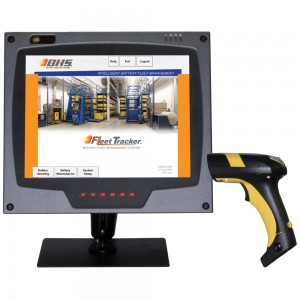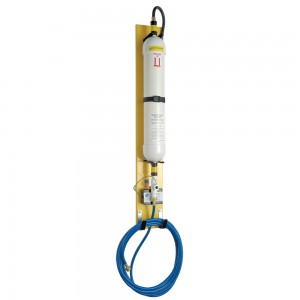We use cookies to make your experience better. To comply with the new e-Privacy directive, we need to ask for your consent to set the cookies. Learn more.
Managing Lift Truck Efficiency with Battery Fleet Management Technology
Introduction: Increasing Battery Room Efficiency Through Software

Figure 1. BHS Fleet Tracker (FLT) is an advanced battery management system that helps to organize inventory and enhance efficiency.
Modern electric fork truck batteries offer significant improvements in performance and efficiency over older technologies, but operations will not realize the full benefits of these new tools without collecting and analyzing data through forklift fleet management software. High-quality lift trucks are a crucial component of any facility, but battery handling practices should always be optimized for their facilities -- best practices will vary from one facility to the next. Material Handling Equipment (MHE) fleet tracking allows for a much higher level of individualization.
To identify areas of weakness, operation managers should understand how inefficiencies can take hold. Inefficient battery handling practices include randomly pulling batteries, over- and under-watering, uneven maintenance intervals, and owning more batteries than the fleet requires for peak efficiency.
Many of these inventory inefficiencies can be easily resolved with battery management software, which offers a comprehensive solution -- software advances allow managers to avoid random estimates, instead creating and implementing custom battery handling strategies. In some instances, better practices will reduce the total cost of battery charging and maintenance by as much as 25 percent.
This article will examine some of the factors that influence inefficiencies in battery handling applications. It will then outline strategies to correct these inefficiencies, with an emphasis on the role of forklift fleet management systems in establishing optimal battery handling procedures.
The Scope of Warehouse Battery Room Efficiency Issues
The total cost of inefficient battery handling is difficult to pinpoint -- there are dozens of variables to consider, including operator behavior -- but aggregated estimates measure waste in the hundreds of thousands of dollars per year for large operations. Even facilities that only run 10 to 20 lift trucks can lose tens of thousands of dollars per annum to poor battery management.
As forklift battery prices increase, managers need to optimize their investments. Some batteries cost as much as 30 percent of the total cost of the lift truck, and early replacements can quickly reduce profitability. Ideally, facilities with up-to-date battery handling equipment should be able to use a battery for five years or more.
In order to extend operating life spans, managers need accurate data. Software battery management strategies can ensure that a facility obtains the greatest possible output from each battery, resulting in a much better return on investment.
The most common threats to battery handling efficiency include:
-
Improper Battery Rotation.
An undercharged battery will provide less operating time prior to recharging, but will still burn a complete charging cycle. Realtime battery rotation tracking prevents undercharged batteries from being used in lift trucks.
-
Maintenance Oversights.
Over- and under-watering, infrequent washing, and missed equalizing charges can occur without adequate monitoring. Every instance of inadequate maintenance limits the life of the battery, decreasing its overall efficiency.
-
Mismatched Inventory Size.
Without the data provided by forklift fleet management software, managers may overextend their budgets by replacing batteries prematurely or buying too many batteries given their fleet sizes, shift requirements, and operating practices. This can also result in unnecessary space usage and clutter in the battery room.
-
Uneven Operating Procedures.
When batteries are not kept on a strict charging, cooling and usage cycle, workers can find themselves waiting for an available battery. Similarly, if staff are not trained to use forklift battery changers in the most efficient way possible, battery changes require more time and effort than is necessary.
Developing Battery Monitoring and Management Strategies to Optimize Investment
A data-driven battery management strategy prevents production losses from the factors listed above and can conceivably reduce inventory by one battery per truck in multi-shift facilities, limiting the number of required batteries by up to 50 percent. An effective battery management strategy includes three distinct operations: ensuring proper rotation, tracking maintenance tasks, and reporting data in an effective manner.
An Improved Approach to Lifting Equipment Battery Rotation Practices
Battery life span is measured in charging cycles, with typical limits of around 2,000 cycles for a new battery. Facilities will see the best possible value from each unit by fully charging with each cycle, then discharging to the recommended minimum capacity of 20 percent. Usage should be equally distributed across the whole bank, reducing the likelihood that a battery will require replacement earlier than similar batteries; this helps to reduce re-orders, further enhancing the investment.
When the operator is left to decide when to perform a change out, the risk of over- or under-charging specific batteries increases significantly. Facilities relying on operator choice alone report that, on average, 30 percent of forklift batteries are underutilized while 20 percent of the inventory is overused. This uneven usage leads to shorter battery life spans and decreased run times for lift trucks.
Forklift fleet management systems like the BHS Fleet Tracker™ can monitor battery usage and charge habits while clearly displaying the location of fully charged batteries. This enables operators to always choose the battery that has charged the longest or recently completed a cooling cycle. Removing the burden of choice from operators also reduces change-out times, redirecting labor costs back into revenue-generating material handling tasks.
Furthermore, battery fleet management systems do not necessarily require a direct connection to battery chargers or additional investment in infrastructure. Instead, they use barcode labeling to ensure ease of use while accurately tracking usage. This allows for some flexibility; the system can be installed in virtually any location that has convenient access to the battery room to ensure that operators will be able to work efficiently.
Tracking Battery Watering, Washing and Other Maintenance Through Forklift Fleet Management
Maintenance tracking is a crucial part of every facility’s battery management strategy. Implementing battery management software is the best way to consistently follow an appropriate maintenance plan, which helps to extend the life of the battery inventory.
To ensure the greatest return on investment for each battery, adequate management software should track three important maintenance operations:

Figure 2. BHS Water Deionizing System (WDS-1) purifies water, improving battery performance and operating life.
-
Watering
- The life expectancy of a forklift battery depends on consistent water levels. Too little water exposes plates, causing sulfation, while too much water will cause electrolytes to boil over, resulting in capacity loss.
Battery management software helps to promote better watering practices, especially when used alongside deionization systems and optimized battery watering devices. Ideal forklift fleet management systems also organize the watering tasks, reporting batteries in order of location for maximum efficiency.
-
Washing
- Without regular washing, short circuits along the battery’s surface disperse energy without channeling that energy into the lift truck. Washing is therefore necessary to prevent energy loss and battery corrosion.
A battery management system with data tracking capabilities can keep every battery on a strict washing schedule, eliminating operator error.
-
Equalizing
- Equalizing charges helps to keep batteries efficient by providing all of the cells with equal voltage and specific gravity. However, it is important to note that equalizing requirements vary widely between manufacturers and applications. Battery management systems can be customized to respond to an operation’s specific needs, maintaining optimal schedules automatically and reducing the likelihood of errors.
Improved Practices for Warehouse Battery Management Data Reporting
Operation managers rely on accurate data collection and reporting to analyze resource losses in material handling. A comprehensive battery management system includes the ability to gather data easily and to report information in a simple yet flexible way.
When battery room supervisors have the ability to collect and analyze data on batteries and trucks, they can easily keep track of important patterns involving service hours and battery run times. Barcode scanners aid in the automation of data collection, increasing compliance with charge schedules and helping to ensure accurate battery tracking.
By analyzing collected data and forecasting long-term results, managers can decide whether to implement new policies, reform current practices or invest in training and infrastructure. Battery management systems allow users to summarize their past activities and predict the results of their practices. They can forecast replacement needs and non-routine maintenance by looking at aggregated data.
To aid in analysis, many management programs can interface with common database standards, allowing for easier reporting and metric tracking. Facility managers can easily find new ways to use data to show a move towards better overall efficiency.
Software Scalability in Battery Fleet Management Systems
As mentioned earlier, flexibility is a key consideration when managing a lift truck or forklift fleet. While large operations require comprehensive management strategies, smaller fleets may benefit from a more simplified approach.
One of the major benefits of software management systems is that they require a relatively small investment, and they scale with the facility. As operations grow, so do the reporting capabilities of the software and the opportunities to correct inefficient battery practices.
Regardless of the size of the facility, the fleet’s workload or operational factors, effective use of forklift fleet management systems can ensure better rotation practices and better reporting. The benefits grow over time as more data is collected and analyzed.
Conclusion: Battery Fleet Management Systems Increase Efficiency in Storage Facility Applications
Battery fleet management systems are an indispensable tool when working towards more efficient lift truck practices. Key advantages include:
- The ability to right-size inventory, eliminating unneeded batteries.
- Battery charge monitoring and rotation management.
- Data collection with user-friendly tools.
- Report generation with customizable data organization mechanisms.
- Elimination of over- or under-use of individual batteries.
- Maintenance interval tracking, with alerts for necessary tasks.
With the ability to measure battery changes and other battery handling tasks, managers can revise their strategies and react to new conditions, making battery management systems a crucial resource for maintaining a productive facility.
References
Bond, Josh. “Lift Truck Tips: Battery management replaces gut reactions and guesswork.” mmh. Peerless Media Network, 1 Apr. 2013. Web. 4 Mar. 2015.
“Maximise your forklift’s battery life.” forkliftbriefing. Mitsubishi Forklift Briefing, 2015. Web. 4 Mar. 2015.
“eTools: Powered Industrial Trucks (Forklift).” osha. Occupational Health and Safety Administration, United States Department of Labor, n.d. Web. 4 Mar. 2015.
Vanasse, Harold. “Other Voices: Lean thinking in the industrial battery room.” mmh. Peerless Media Network, 17 Sept. 2014. Web. 4 Mar. 2015.
Vanasse, Harold. “Other Voices: Three major impacts on battery room operation and maintenance - #1: Battery rotation.” mmh. Peerless Media Network, 23 December 2014. Web. 4 Mar. 2015.
Williams, Del. “Develop a Battery Management Strategy.” mhlnews. Material Handling & Logistics, 24 Sept. 2010. Web. 4 Mar. 2015

